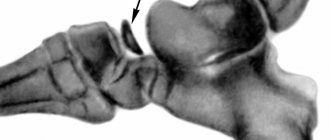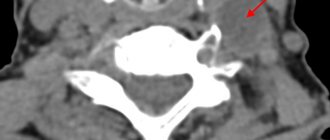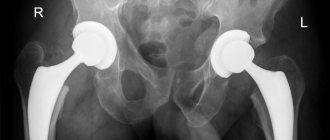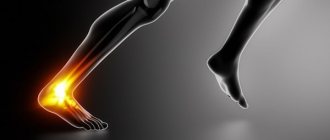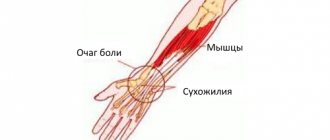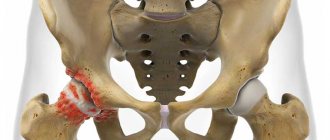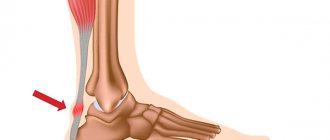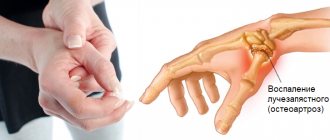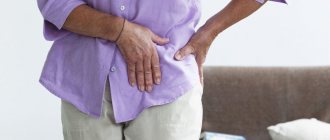An irreversible phenomenon during which cells, tissues, and organs cease their vital activity is called necrosis. It can be triggered by pathogenic microbes, mechanical, thermal, chemical, infectious and toxic agents that contribute to tissue destruction. In addition, necrosis can occur as a result of allergies or impaired blood circulation. Taking into account the state of the body and unfavorable local factors, it is possible to determine the pronounced degree of cell necrosis.
The provoking factors for the occurrence of necrosis are pathogenic microorganisms, fungi, and viruses. If blood circulation is impaired and there is hypothermia in this part of the body, vascular spasm will increase and severe disruption of blood circulation will occur. With excessive overheating, metabolism increases, and if blood circulation is impaired, the risk of developing a necrotic process increases.
How does necrosis manifest itself?
If we talk about the first symptoms of necrosis, they are presented in the form of numbness and lack of sensitivity. In such a situation, you must immediately visit an experienced and qualified doctor at a medical center. In addition, the skin becomes pale. This happens because blood circulation is impaired. Over time, the skin will acquire a bluish tint, then turn black or dark green. In the presence of necrosis in the lower extremity, a person notices rapid fatigue while walking, a feeling of coldness, cramps appear, as well as lameness, as a result of which non-healing trophic ulcers will form, which will necrotize over time.
Due to the fact that the respiratory and central nervous systems, kidneys, and liver cease to function normally, blood circulation is disrupted, and a person’s general condition of the entire body deteriorates. In addition, the immune system decreases, as concomitant blood diseases, anemia appear, and metabolic processes are disrupted, the body is depleted, hypovitaminosis and fatigue are observed.
What is the disease
Osteonecrosis is the death of osteocytes (bone cells) and bone marrow tissue as a result of impaired blood supply to the bone.
Osteonecrosis reduces the ability of the joint to perform its functions and causes pain. In advanced cases, joint mobility is lost irreversibly, and then prosthetics are required.
Most often, the femoral bones in the head region are exposed to the destructive effects of osteonecrotic changes. Then, in descending order, there is osteonecrosis of the hip joints, knee joints, shoulder joints, osteonecrosis of the talus block and smaller joints of the wrists and feet. In a number of cases, osteonecrosis of the jaw has been noted.
With the traumatic nature of the disease, specific injured joints are subject to the greatest destruction. With non-traumatic pathogenesis, dystrophic changes affect the joints symmetrically in places of maximum load. Differentiation of cases of osteonecrosis by gender is expressed in the fact that osteonecrosis of the femoral head is most typical for men, and osteonecrosis of the knee joint is most common for women.
The age categories of patients susceptible to the disease are from 20 years and above.
The disease progresses through several stages:
- There is no pathology;
- Disturbances appear in the form of sclerotic processes and cysts;
- The destruction of the joint takes the shape of a “crescent”;
- Deformities of the knee joint develop.
Varieties
Given the changes that occur in the tissue, there are some forms of necrosis. Namely:
- The cause of coagulation or dry necrosis is the folding, compaction, drying of tissue protein, which then becomes a curdled mass. This is the result of the fact that blood has stopped flowing and moisture has evaporated. Areas of tissue become dry, brittle, and also acquire a dark brown or yellowish gray tint with clear demarcation lines. In the place where the dead tissue was rejected, ulcers will appear, a purulent process will develop, and an abscess will form. The localization of dry necrosis is the spleen, kidneys, and umbilical cord stump in a newborn child.
- With colliculative or wet necrosis, swelling, softening and liquefaction of dead tissue occurs, and a mass with a gray tint is formed and a putrid odor appears.
There are some types of necrosis
1. If the blood supply to a tissue or organ suddenly stops, a heart attack occurs. The term ischemic necrosis refers to the death of any part of a vital organ (brain, heart, intestines, lungs, kidneys, spleen). If the infarction is small, autolytic melting or resorption is observed, followed by tissue restoration. A heart attack can result in impaired tissue functioning, various complications, and even death.
2. If necrosis of a section of bone tissue occurs, the localization of which is the sequestral cavity, this is called sequestration. In such a situation, this area will separate from healthy tissue. The reason for this is a purulent process.
3. Death of the skin, mucous surface, and muscle tissue is called gangrene. The cause of gangrene is tissue necrosis.
4. The presence of bedsores is observed in a person who is completely immobilized. This is explained by prolonged compression of the tissue and damage to the skin. As a result, deep purulent ulcers form.
Treatment
Conservative treatment of avascular necrosis allows you to stop the course of the disease. It assumes:
- using medications that do not contain steroids to relieve pain and reduce inflammation;
- the use of vasodilators that improve blood circulation;
- physiotherapeutic procedures;
- massage that increases the functionality of muscle tissue;
- physical therapy classes;
- use of orthopedic pads.
Surgical treatment is prescribed in cases where the process of disease development has gone too far. Depending on the degree of joint damage, the following operations can be performed:
- osteotomy (during the operation, the tissue is aligned, which allows you to relieve tension from the joint or bone);
- surgical decompression (partial removal of the inside of the bone, which reduces pressure);
- installation of a bone graft;
- installation of a vascularized bone graft (patient tissue is used for transplantation;
- During the operation, healthy bone is transplanted from another place to the site of the damaged bone);
- endoprosthetics (replacement of a damaged joint with a synthetic implant).
Stages of the disease
There are several stages of development of this disease. The first stage is characterized by a slight change in bone tissue, when the hip joint maintains functionality, and painful sensations are periodic. At the second stage, cracks begin to form on the surface of the joint, its mobility is impaired, and the person experiences constant pain. The third stage is called secondary arthrosis, when the acetabulum is involved in the process. There is a significant decrease in joint mobility. This stage is manifested by constant and severe pain. At the fourth stage, the bone begins to deteriorate, the muscles atrophy, and the pain is not eliminated by medications.
Diagnostics
Bone damage can be detected only after undergoing a special examination with radiography or MRI. Laboratory tests of blood and urine also help determine the stage of the disease; markers of bone resorption are determined - their presence in the blood or urine indicates the destruction of bone tissue.
| Injection into the joint for necrosis of the knee joint |
Sign up for treatment
What is aseptic necrosis of the femoral head
The head of the femur is considered a problem area where there is an increased risk of arterial blockage and cumulative damage caused by overload and household injuries. The presence of various pathological processes can provoke aseptic necrosis of the thigh.
The main reasons include long-term use of hormonal drugs and antibacterial agents. And also, if a person abuses alcohol, he is often in a stressful state. The provoking factor may be the presence of congenital hip dislocation, osteopenia, osteoporosis, systemic lupus erythematosus, ankylosing spondylitis, rheumatoid arthritis.
The majority of cases have a disappointing orthopedic prognosis and the presence of severe deforming arthrosis. In such a situation, the patient is prescribed endoprosthetics, joint arthrodesis or corrective osteotomy. If magnetic resonance imaging is performed in a timely manner, the disease can be detected at an early stage, which can be treated using conservative methods.
Disability
ANGKB affects all areas of life: health, performance, socialization. With a long duration of the disease at different stages of conservative treatment, patients were forced to change activities with increased physical activity. They choose professions that do not require long periods of being on their feet, moving, or close to their place of residence.
The disability group of such people is determined during a medical and social examination in accordance with the Appendix to the Order of the Ministry of Health of the Russian Federation dated January 27, 1977 No. 33 to the Resolution of the Ministry of Labor and Social Development of the Russian Federation dated January 27, 1977 No. 1: “Classifications and temporary criteria used in the implementation of medical social expertise".
Disability is assigned based on the severity of the disease and decreased quality of life. Changes in the level of disability were carried out only in the case of surgical intervention.
In other words, surgical intervention is most effective in treating aseptic necrosis. Despite the impressiveness of conservative treatment methods, proven effectiveness is questionable.
What is necrosis of the hip and knee joints
The hip joint includes the acetabulum and the head of the femur. The hip joint is the largest ball-and-socket joint in the human body. It is supplied by a single artery passing through the neck of the femur.
If blood circulation is disrupted, the blood supply to the area will be disrupted, and oxygen and nutrients will not be supplied, and bone tissue will lose its properties. The recovery process will become impossible, osteoarthritis will appear, which is accompanied by severe pain.
After some time, necrosis of the hip joint develops. In such a situation, the patient needs to replace the damaged joint. For this, an artificial analogue is used. The procedure is called endoprosthetics, when motor activity is completely restored.
Destructive processes in the knee joint occur as a result of injury and loss of blood supply. The joints lose their functions, and the person may become disabled. With aseptic necrosis of the knee joint, a person experiences severe pain and observes that the motor ability of the knee has decreased. Magnetic resonance imaging and bone scanning can detect early changes, thereby preventing further bone loss.
Using non-steroidal anti-inflammatory drugs can get rid of pain and reduce inflammation. If a person is indicated for surgery, a bone transplant will be performed.
Causes of bone necrosis
The causes of necrosis of the knee joint are considered to be:
- vasculitis, inflammation of blood vessels leads to impaired blood supply;
- obesity, hyperlipidemia impede blood flow;
- Excessive physical overload;
- Professional sports;
- Joint injuries and their consequences;
- Alcoholism
- Osteochondropathies of the bones that form the knee joint can also provoke Osgood-Schlatter, Koenig and Larsen-Johansson diseases.
- Hereditary diseases and genetic predisposition
What is necrosis of the talus and humerus?
With this disease, painful sensations appear in the shoulder joint, its movement is limited, as a result of which the risk of atrophy increases. A rare phenomenon includes an altered structure of the humerus. As the disease progresses, the patient is prescribed surgical intervention, which is called endoprosthetics. In this situation, this is the only way to restore lost functions of the upper limbs.
Necrosis of the talus occurs spontaneously and rapidly progresses. With degenerative changes in the ankle joint, deforming arthrosis develops. Thanks to modern diagnostic methods used in the medical center, it is possible to determine the early stage of changes in the ankle joint. In such a situation, mosaic osteochondroplasty is used, as a result of which the anatomy of the joint is restored.
Types of bone destruction
There are 4 types of osteonecrosis:
- Ischemic (aseptic, avascular). Necrosis of the knee joint occurs due to circulatory problems. Diagnosed in people aged 35-45 years against the background of alcohol dependence or long-term use of corticosteroids.
- Associated with chronic diseases - for example osteoporosis, arthritis or arthrosis of the knee joint. Slow inflammation leads to malnutrition and the development of tissue necrosis.
- Medication. Occurs as a result of taking medications that can disrupt bone nutrition.
- Sporadic. Develops due to the progression of genetic diseases.
Diagnostic measures
If necrosis is suspected, the patient may be sent for an X-ray examination. However, it should be taken into account that this method does not detect pathology at the initial stage of development. An X-ray can reveal pathology if it has progressed to the second or third stage. During the study of this disease, taking a blood test will also not bring an effective result. Thanks to modern devices that are used for magnetic resonance and computed tomography, it is possible to detect changes in tissue structure in a timely manner and with maximum accuracy.
Symptoms
The list of main clinical signs of AN includes severe pain in the affected joints, aggravated by exercise, dysfunction of the joints, and changes in the axes of the limbs.
Increased manifestations are observed as the disease progresses. Thus, in the first stage of necrosis, the discomfort is short-term (for this reason, it is difficult to identify the anomaly). Some patients complain of discomfort that occurs when starting any movement in the joint. Morning stiffness goes away quickly.
The next degree is characterized by the presence of pain at night.
During the day it is difficult to step on the affected leg; a person tries to reduce the load on the joint. Lameness occurs.
The penultimate form of development of the disease is characterized by the presence of constant discomfort; fourth - minimizing independent movements in the knee. The pain is not relieved by taking medications.
How does necrosis end?
A favorable outcome of the pathology will be with enzymatic melting of tissues, germination of connective tissues into the remaining dead tissue, followed by the formation of a scar. The area of necrosis can become overgrown with connective tissue, resulting in the formation of a capsule. In addition, bone can form in the dead area. This phenomenon is called ossification.
An unfavorable outcome of the pathological condition is characterized by purulent melting, as a result of which the risk of bleeding and spread of the lesion increases. This is how sepsis will develop.
With ischemic stroke, myocardial infarction, necrosis of the kidney or pancreas, that is, when vital organs are affected, there is a high probability of death.
When to see a doctor
In the initial stages of avascular bone necrosis, many patients do not notice any symptoms. Most often, avascular necrosis affects the hip, knee, shoulder, wrist and ankle joints. The disease often develops on both sides of the body, meaning both knees or both hips can be affected at the same time.
Symptoms of avascular necrosis
- joint pain during physical activity or at rest; impaired functionality of the joint, resulting in limited movement;
- pain in the groin and thigh muscles (if the hip joint is affected);
- When the knee joint is affected, pain may be felt on the inner surface of the joint.
If the pain in one of the joints does not go away for a long time and even intensifies, it is necessary to undergo diagnostics and begin treatment. In an advanced state, the disease can cause serious complications.
